Related Research Articles
In literary criticism, a Bildungsroman is a literary genre that focuses on the psychological and moral growth of the protagonist from childhood to adulthood, in which character change is important. The term comes from the German words Bildung and Roman ("novel").

Amantine Lucile Aurore Dupin, best known by her pen name George Sand, was a French novelist, memoirist, and journalist. One of the most popular writers in Europe in her lifetime, being more renowned than both Victor Hugo and Honoré de Balzac in England in the 1830s and 1840s, Sand is recognised as one of the most notable writers of the European Romantic era.
Romain Gary, born Roman Kacew, was a French novelist, diplomat, film director, and World War II aviator. He is the only author to have won the Prix Goncourt under two names. He is considered a major writer of French literature of the second half of the 20th century. He was married to Jean Seberg.
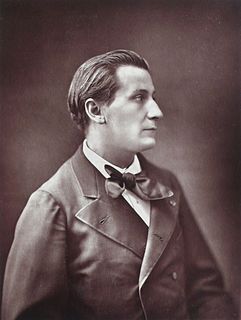
François Edouard Joachim Coppée was a French poet and novelist.

Paul Auguste Marie Adam was a French novelist who became an early proponent of Symbolism in France, and one of the founders of the Symbolist review Le Symboliste.
A book series is a sequence of books having certain characteristics in common that are formally identified together as a group. Book series can be organized in different ways, such as written by the same author, or marketed as a group by their publisher.

Claude Fauchet was a sixteenth-century French historian, antiquary, and pioneering romance philologist. Fauchet published the earliest printed work of literary history in a vernacular language in Europe, the Recueil de l'origine de la langue et poësie françoise (1581). He was a high-ranking official in the governments of Charles IX, Henri III, and Henri IV, serving as the president of the Cour des monnaies.

Jules Laforgue was a Franco-Uruguayan poet, often referred to as a Symbolist poet. Critics and commentators have also pointed to Impressionism as a direct influence and his poetry has been called "part-symbolist, part-impressionist". Laforgue was a model for Pierre-Auguste Renoir, including for Renoir's 1881 painting Luncheon of the Boating Party.

Jules Romains was a French poet and writer and the founder of the Unanimism literary movement. His works include the play Knock ou le Triomphe de la médecine, and a cycle of works called Les Hommes de bonne volonté . Sinclair Lewis called him one of the six best novelists in the world.
20th-century French literature is literature written in French from 1900 to 1999. For literature made after 1999, see the article Contemporary French literature. Many of the developments in French literature in this period parallel changes in the visual arts. For more on this, see French art of the 20th century.

Jacques Rivière was a French "man of letters" — a writer, critic and editor who was "a major force in the intellectual life of France in the period immediately following World War I". He edited the magazine La Nouvelle Revue Française (NRF) from 1919 until his death. He was influential in winning a general public acceptance of Marcel Proust as an important writer. His friend and brother-in-law was Alain-Fournier, with whom he exchanged an abundant correspondence.

L'Abbaye de Créteil or Abbaye group was a utopian artistic and literary community founded during the month of October, 1906. It was named after the Créteil Abbey, as most gatherings took place in that suburb of Paris.

Saint-Avertin is a commune in the Indre-et-Loire department in central France.

Auguste Marie Joseph Jean Léon Jaurès, commonly referred to as Jean Jaurès, was a French Socialist leader. Initially a Moderate Republican, he later became one of the first social democrats and the leader of the French Socialist Party in 1902, which opposed Jules Guesde's revolutionary Socialist Party of France. The two parties merged in 1905 in the French Section of the Workers' International (SFIO). An antimilitarist, Jaurès was assassinated at the outbreak of World War I, and remains one of the main historical figures of the French Left. Jaurès was a heterodox Marxist: he rejected the dictatorship of the proletariat and tried to conciliate idealism and materialism, individualism and collectivism, democracy and class struggle, patriotism and internationalism.
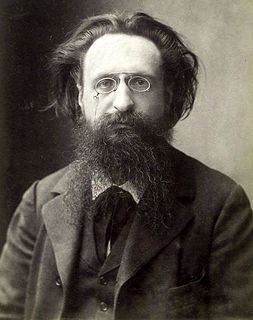
Jules Bazile, known as Jules Guesde was a French socialist journalist and politician.
Les lauriers sont coupés is an 1887 novel by French author Édouard Dujardin, first published in the magazine Revue Indépendante. He was an early user of the literary technique stream of consciousness, and Les Lauriers exemplifies the style. Dujardin claimed later, in a study of the technique and its application in Joyce's Ulysses, that he was the first to use it in Les Lauriers.
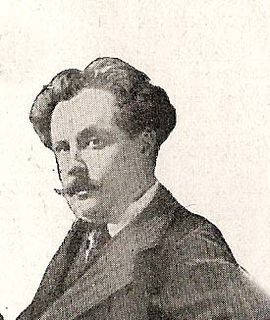
Georges Jules Charles Pioch was a French poet, journalist, pacifist and socialist intellectual. He was president of the International League for Peace from 1930–37.
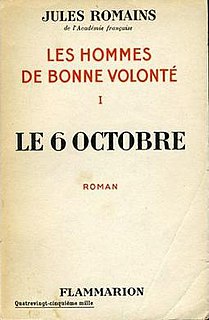
Les Hommes de bonne volonté is an epic roman-fleuve by French writer Jules Romains, published in 27 volumes between 1932 and 1946. It has been classified both as a novel cycle and a novel and, at two million words and 7,892 pages, has been cited as one of the longest novels ever written.

Louis Énault was a French journalist, novelist and translator. He sometimes used the pseudonym Louis de Vernon.
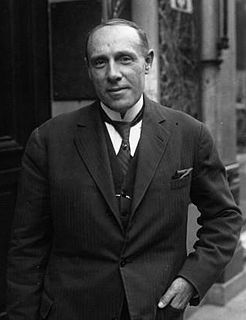
André Robert Gustave Nepveu, known under his pseudonym Luc Durtain, was a French poet, novelist, journalist, playwright and a physician by profession.
References
- 1 2 3 Bergholz, Harry (April 1951). "Jules Romains and His "Men of Good Will"". The Modern Language Journal. 35 (4): 303–309. doi:10.1111/j.1540-4781.1951.tb01639.x. JSTOR 319619.
- ↑ "Men of Good Will". Encyclopædia Britannica. 26 May 2011. Retrieved 25 January 2018.
- ↑ Tame, Peter (April 1999). "La Part du mal: essai sur l'imaginaire de Jules Romains dans 'Les Hommes de bonne volonté' by Dirck Degraeve (review)". The Modern Language Review. 94 (2): 547–548. doi:10.2307/3737179. JSTOR 3737179.
- 1 2 "Unanimism". Encyclopædia Britannica. 6 October 2017. Retrieved 25 January 2018.
- ↑ Taylor, Karen L. (2006). The Facts on File Companion to the French Novel. Infobase Publishing. p. 349. ISBN 978-0-8160-7499-0.